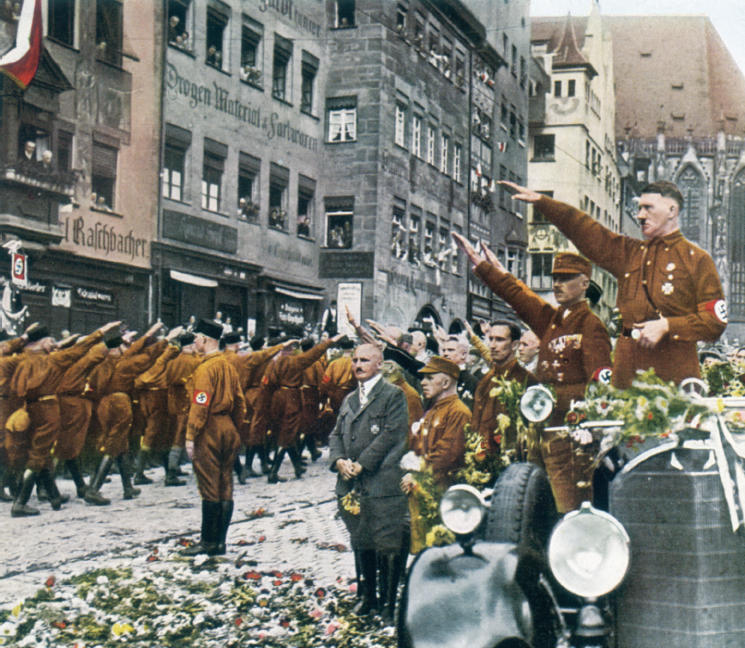America’s History: Printed Page 768
America: A Concise History: Printed Page 695
America’s History: Value Edition: Printed Page 676
The Rise of Fascism
World War II had its roots in the settlement of World War I. Germany struggled under the harsh terms of the Treaty of Versailles, and Japan and Italy had their desire for overseas empires thwarted by the treaty makers. Faced with the expansive ambitions and deep resentments of those countries, the League of Nations, the collective security system established at Versailles, proved unable to maintain the existing international order.
Fascism, as instituted in Germany by Hitler, combined a centralized, authoritarian state, a doctrine of Aryan racial supremacy, and intense nationalism in a call for the spiritual reawakening of the German people. Fascist leaders worldwide disparaged parliamentary government, independent labor movements, and individual rights. They opposed both the economic collectivism of the Soviet Union — where, in theory, the state managed the economy to ensure social equality — and the competitive capitalist economies of the United States and Western Europe. Fascist movements arose around the world in the 1930s but managed to achieve power in only a handful of countries. Those countries were at the center of global war making in the 1930s.
Japan and Italy The first challenge came from Japan. To become an industrial power, Japan required raw materials and overseas markets. Like the Western European powers and the United States before it, Japan embraced an expansionary foreign policy in pursuit of colonial possessions and overseas influence. In 1931, its troops occupied Manchuria, an industrialized province in northern China, and in 1937 the Japanese launched a full-scale invasion of China. In both instances, the League of Nations condemned Japan’s actions but did nothing to stop them.
Japan’s defiance of the League encouraged a fascist leader half a world away: Italy’s Benito Mussolini, who had come to power in 1922. Il Duce (The Leader), as Mussolini was known, had long denounced the Versailles treaty, which denied Italy’s colonial claims in Africa and the Middle East after World War I. As in Japan, the Italian fascists desired overseas colonies for raw materials, markets, and national prestige. In 1935, Mussolini invaded Ethiopia, one of the few remaining independent countries in Africa. Ethiopian emperor Haile Selassie appealed to the League of Nations, but the League’s verbal condemnation and limited sanctions, its only real leverage, did not stop Italy from taking control of Ethiopia in 1936.

Hitler’s Germany Germany, however, posed the gravest threat to the existing world order. Huge World War I reparation payments, economic depression, fear of communism, labor unrest, and rising unemployment fueled the ascent of Adolf Hitler and his National Socialist (Nazi) Party. When Hitler became chancellor of Germany in 1933, the Reichstag (the German legislature) granted him dictatorial powers to deal with the economic crisis. Hitler promptly outlawed other political parties, arrested many of his political rivals, and declared himself führer (leader). Under Nazi control, the Reichstag invested all legislative power in Hitler’s hands.
Hitler’s goal was nothing short of European domination and world power, as he had made clear in his 1925 book Mein Kampf (My Struggle). The book outlined his plans to overturn the territorial settlements of the Versailles treaty, unite Germans living throughout central Europe in a great German fatherland, and annex large areas of Eastern Europe. The “inferior races” who lived in these regions — Jews, Gypsies, and Slavs — would be removed or subordinated to the German “master race.” These territories would provide Germany with what Hitler called “lebensraum” — a new region of settlement and farming and a source of natural resources. A virulent anti-Semite, Hitler had long blamed Jews for Germany’s problems. Once in power, he began a sustained and brutal persecution of Jews, which expanded into a campaign of extermination in the early 1940s.
In 1935, Hitler began to rearm Germany, in violation of the Versailles treaty. No one stopped him. In 1936, he sent troops into the Rhineland, a demilitarized zone under the terms of Versailles. Again, France and Britain took no action. Later that year, Hitler and Mussolini formed the Rome-Berlin Axis, a political and military alliance between the two fascist nations. Also in 1936, Germany signed a pact to create a military alliance with Japan against the Soviet Union. With these alliances in place, and with France and Great Britain reluctant to oppose him, Hitler had seized the military advantage in Europe by 1937.
IDENTIFY CAUSES
Question
What motivated Japanese, Italian, and German expansionism?